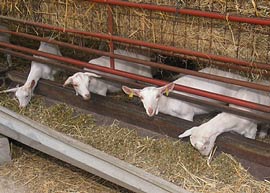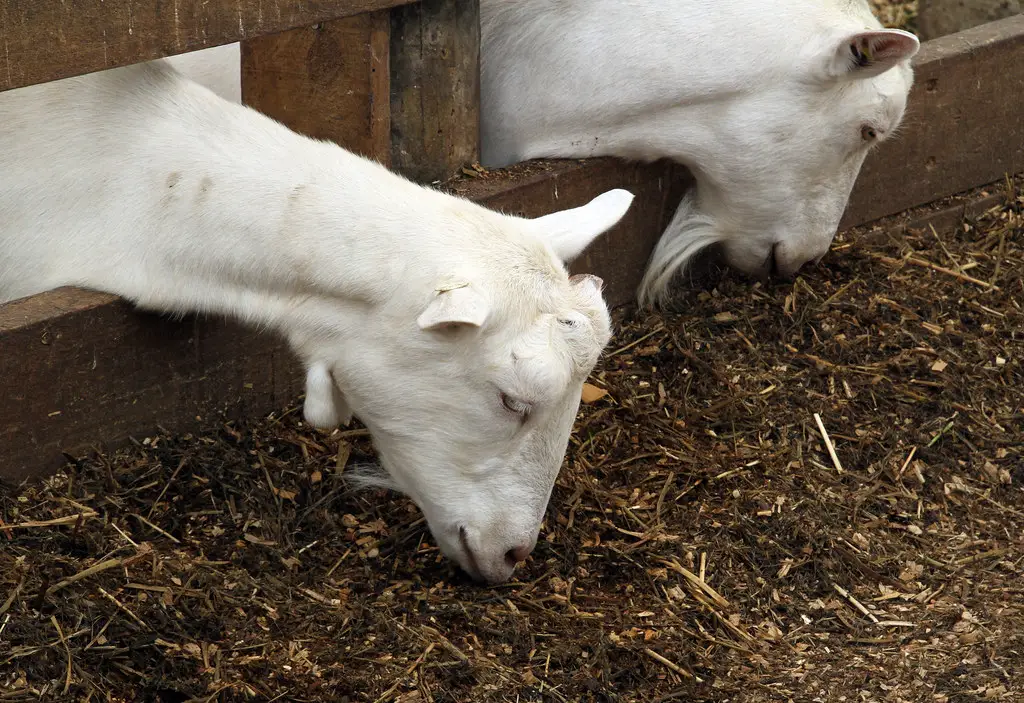Yes, goats can eat silage, which is a fermented fodder made from crops like grass and corn. Goats can safely consume silage, which is a type of fodder made by fermenting crops like grass and corn.
This fermented feed is popular among farmers as it provides a high-quality source of nutrition for livestock. Silage is rich in fiber and essential nutrients, making it a suitable choice for goats. However, it is crucial to ensure that the silage is of good quality, properly fermented, and free from harmful molds or toxins.
Additionally, goats should have a balanced diet that includes other forages and supplements to meet their nutritional requirements. By including silage in their diet, goats can enjoy a nutritious and well-rounded meal.
What Is Silage?
When it comes to the diet of goats, it’s essential to understand what they can and cannot eat. One common feed that farmers often consider for their goats is silage. Silage is a type of livestock feed that is made by fermenting and preserving green forage crops. Essentially, it is a combination of crops such as corn, grasses, legumes, or other high-moisture plants that have been chopped into small pieces and stored in airtight conditions. Silage provides essential nutrients that are beneficial for goats’ health and overall well-being.
Definition Of Silage
Silage is a feed that is fermented and preserved under anaerobic conditions. It is made by chopping fresh forage crops into small pieces and storing them in airtight containers, such as silos or plastic wraps. This anaerobic storage preserves the feed by inhibiting the growth of spoilage organisms and promoting lactic acid fermentation, which helps in the preservation process.
How Silage Is Made
Making silage involves several steps that ensure proper fermentation and preservation. Here’s a brief overview of the process:
- Crop selection: Farmers select high-moisture forage crops, such as corn, grasses, legumes, or a combination of these, based on the nutritional needs of their livestock.
- Harvesting: The chosen crops are harvested at the right stage of maturity, typically when the moisture content is around 65-70%.
- Chopping: The harvested crops are then chopped into small pieces using specialized equipment, such as forage harvesters or choppers. Smaller pieces facilitate better fermentation and packing.
- Packing: The chopped crops are tightly packed into airtight containers, such as silos or plastic wraps, to exclude oxygen and create anaerobic conditions necessary for the fermentation process.
- Fermentation: The anaerobic conditions promote the growth of lactic acid bacteria, which ferment the sugars present in the forage crops. This fermentation process results in a lower pH and the production of organic acids, which aid in the preservation of the silage.
- Maturation: After a few weeks of fermentation, the silage is considered mature and ready for feeding.
Different Types Of Silage
Silage can be made from various types of forage crops, depending on the availability and nutritional goals. Here are some common types of silage:
| Type of Silage | Primary Crop |
|---|---|
| Corn Silage | Corn |
| Grass Silage | Grass species (ryegrass, fescue, etc.) |
| Legume Silage | Legume species (alfalfa, clover, etc.) |
| Mixed Silage | Combination of various forage crops |
The choice of silage type depends on factors such as the goat’s nutritional requirements, availability of crops, and the desired quality of the feed.

Credit: www.britishgoatsociety.com
Nutritional Value Of Silage For Goats
Silage is a popular and widely used feed option for livestock, including goats. It offers several nutritional benefits that can contribute to the overall health and well-being of goats. In this section, we will explore the essential nutrients in silage, the benefits of feeding silage to goats, and potential drawbacks or concerns that goat owners should be aware of.
Essential Nutrients In Silage
Silage is a fermented feed that is typically made from crops such as corn, grass, or legumes. During the fermentation process, the natural sugars present in these crops are converted into organic acids, preserving the nutrients and ensuring their availability to the animals. Silage contains a range of essential nutrients necessary for goats’ growth, production, and development. These nutrients include:
- Vitamins: Silage is a rich source of vitamins such as vitamin A, which is important for maintaining optimal vision and immune function in goats. It also contains vitamin E, which acts as an antioxidant and plays a crucial role in supporting reproductive health.
- Minerals: Silage provides essential minerals like calcium, phosphorus, and magnesium, which are vital for bone development and overall metabolic functions in goats. These minerals also contribute to the proper functioning of goat’s nervous, muscular, and immune systems.
- Proteins: Silage contains significant amounts of proteins that serve as building blocks for tissues, muscle growth, and milk production in lactating goats. These proteins are essential for maintaining healthy body condition and supporting the overall growth and development of goats.
- Fiber: Silage provides a good source of dietary fiber, which is crucial for healthy digestion and rumen function in goats. The fiber in silage aids in the fermentation process within the rumen, promoting a healthy gut microbiota, and preventing digestive disorders.
Benefits Of Feeding Silage To Goats
Feeding silage to goats offers several benefits that contribute to their overall health and performance:
- Improved Nutrition: Silage is a highly nutritious feed option that provides a well-rounded and balanced diet for goats. It ensures that goats receive an adequate supply of essential nutrients, promoting their overall growth, production, and reproductive health.
- Enhanced Palatability: Silage is typically sweet and flavorful due to the fermentation process, making it highly palatable to goats. This can encourage increased feed consumption and help maintain good appetite, especially during periods of low-quality forage availability.
- Year-round Availability: Silage can be stored for extended periods without compromising its nutritional value, making it an ideal feed option for year-round feeding. This ensures a consistent and stable food supply for goats, regardless of the seasonal availability of fresh forage.
- Increase in Milk Production: Feeding silage to lactating goats can significantly increase milk production due to its high protein and energy content. The improved nutritional profile of silage can positively impact the quality and quantity of milk, benefiting both goat producers and their customers.
Potential Drawbacks Or Concerns
While silage offers numerous benefits as a feed option, there are a few potential drawbacks and concerns that goat owners should be aware of:
- Mold and Spoilage: Silage can be susceptible to mold growth and spoilage if not properly harvested, processed, and stored. Moldy silage can contain harmful toxins that can lead to health issues in goats. It is crucial to follow proper silage-making practices and regularly inspect and monitor the quality of silage to avoid any potential risks.
- Low Dry Matter Content: Silage typically has a high moisture content, which can result in a lower concentration of dry matter. This can impact the overall nutrient intake and energy density of the diet. It’s important to consider the moisture content and adjust the dietary plan accordingly to ensure goats receive the appropriate levels of nutrition.
- Acidic pH: The fermentation process of silage can lead to a decrease in pH levels, resulting in a more acidic environment. While goats can adapt to some acidity, excessive acid levels can disrupt rumen function and negatively affect digestion. It’s crucial to gradually introduce silage into the goat’s diet and monitor their health and rumen function.
Factors To Consider Before Feeding Silage To Goats
When it comes to feeding goats, it’s important to provide them with a balanced diet that meets their nutritional needs. One option that is often considered is silage, which is fermented, high-moisture fodder that can come from various crops like corn, grass, or legumes. However, before incorporating silage into a goat’s diet, there are several factors that need to be taken into account to ensure their health and well-being.
Age And Health Of Goats
As with any livestock, the age and health of goats play a crucial role in determining whether they can safely consume silage. Young goats or kids, for example, have more sensitive digestive systems and may struggle to process the high moisture content of silage. Therefore, it is generally recommended to introduce silage slowly and gradually to kids, allowing their digestive system to adjust over time.
Similarly, goats that have existing health issues or compromised immune systems may not be able to tolerate silage. It is crucial to consider any specific health conditions or dietary restrictions that your goats might have before deciding to feed them silage. Consulting with a veterinarian can be beneficial in determining if your goats are suitable candidates for silage consumption.
Quantity And Frequency Of Feeding
When incorporating silage into a goat’s diet, it is essential to take into account the quantity and frequency of feeding. Silage is highly nutritious and can be an excellent source of energy for goats. However, it should be fed in moderation and balanced with other types of forage to ensure a well-rounded diet.
The recommended quantity of silage will depend on the nutritional requirements of your goats, their overall body condition, and the availability of other forage sources. Overfeeding silage can lead to digestive issues and may unbalance the goat’s diet. Additionally, it’s crucial to provide your goats with access to fresh water at all times to aid in digestion and prevent dehydration.
Testing And Analyzing Silage Quality
Before feeding silage to goats, it is essential to test and analyze its quality. Silage should have a desirable moisture content, generally around 60-70%, to ensure proper fermentation and preservation. If the moisture content is too high, it can lead to mold growth and spoilage, which can be harmful to goats.
There are various methods available to analyze the quality of silage, including assessing its smell, color, texture, and pH level. Additionally, getting a nutritional analysis done can provide valuable information about the nutrient composition, such as protein, fiber, and energy content.
Regularly monitoring the quality of your silage is important to ensure that it remains safe and nutritious for your goats. If any signs of spoilage or deterioration are detected, it is recommended to discontinue its use and seek alternative forage options.
How To Safely Introduce Silage Into Goats’ Diet
Adding silage to a goat’s diet can be a nutritious and cost-effective alternative to traditional forage. However, it is essential to introduce silage gradually and monitor the goats’ response to ensure their health and well-being. In this article, we will explore the gradual transition process, monitoring goats’ response to silage, and potential dietary adjustments to make the introduction of silage a success.
Gradual Transition Process
When introducing silage into a goat’s diet, it is crucial to do it gradually to allow their digestive system to adjust. Abrupt changes in diet can lead to digestive upsets, and goats are sensitive animals that require a careful transition. Here are steps to follow:
- Start by offering small amounts of silage alongside their regular forage. Begin with as little as 10% of their total forage intake to avoid overwhelming their digestive system.
- Monitor their response over a few days. If the goats show no signs of digestive issues, gradually increase the quantity of silage over time.
- Continue increasing the amount of silage while reducing their regular forage proportionally. This gradual transition allows their rumen microbes to adapt to the new feed source.
- Monitor goats closely during the transition process, observing their overall health, stool consistency, and appetite. Any signs of distress or abnormal behavior should be addressed immediately.
Monitoring Goats’ Response To Silage
During the transition process, it is essential to carefully monitor the goats’ response to the introduction of silage. Here are some key factors to observe:
- Appetite: Check if the goats continue to eat the silage willingly. A decrease in appetite could indicate their hesitation or preference for their usual forage.
- Stool consistency: Assess the consistency of their droppings. Loose or watery stools may suggest difficulty digesting silage or an imbalance in the overall diet.
- Health: Observe the goats’ overall health and well-being. Any noticeable changes in behavior, coat condition, or weight should be addressed promptly.
Potential Dietary Adjustments
As goats adapt to the introduction of silage into their diet, it may be necessary to make some dietary adjustments to ensure their nutritional needs are met adequately. Here are some considerations:
- Nutrient balance: Silage may have different nutrient profiles compared to traditional forage. Regularly analyze the silage for its nutritional content and make adjustments, if necessary, to balance the overall diet.
- Supplementation: Depending on the quality of the silage and the specific nutritional requirements of the goats, additional supplementation such as vitamins, minerals, or protein might be needed. Consult with a veterinarian or nutritionist for proper supplementation recommendations.
- Observation: Continue to monitor the goats’ response to the adjusted diet, ensuring their health and weight remain stable. Make further adjustments as needed based on their individual needs.
By following the gradual transition process, closely monitoring goats’ response to silage, and making appropriate dietary adjustments, you can safely introduce silage into their diet without compromising their well-being. Remember, the health of your goats should always be the top priority when considering any changes to their diet.
Common Issues And Troubleshooting With Silage Feeding
Silage feeding can pose common issues and troubleshooting challenges. However, it is important to note that goats can safely consume silage, but certain precautions must be taken to ensure their health and well-being. Proper introduction, monitoring, and gradual adjustment can help goats adapt to silage without any issues.
Digestive Issues In Goats
Goats are sensitive creatures when it comes to their digestive systems. Feeding them silage can sometimes lead to digestive issues that can impact their health and overall well-being. One common issue is the fermentation process of silage, which can produce high levels of lactic acid that may upset a goat’s stomach. The lactic acid can also disrupt the balance of bacteria in the rumen, leading to further digestive problems.Signs Of Silage Intolerance Or Allergies
It’s important to monitor your goats closely for any signs of silage intolerance or allergies. Some common signs to watch out for include:- Increased flatulence (excessive gas)
- Diarrhea or loose stools
- Abdominal pain or discomfort
- Decreased appetite
- Weight loss or poor weight gain
Effective Solutions And Management Techniques
- Gradual Introduction: Introduce silage gradually to allow your goats’ digestive systems to adjust. Start with small amounts and increase slowly over time.
- Quality Check: Ensure that the silage you are feeding is of high quality and has gone through the proper fermentation process. Poorly fermented silage can lead to more digestive problems.
- Balance Diet: Silage should not be the sole source of nutrition for your goats. Incorporate a balanced diet consisting of hay or pasture, grains, and other forages. This will help provide a well-rounded nutrition and lessen the chances of digestive issues.
- Monitor Health: Regularly monitor the health of your goats by observing their body condition, stool consistency, and overall behavior. Any changes should be addressed promptly and necessary adjustments made to their diet.
- Consult a Veterinarian: If you’re experiencing consistent issues with silage feeding, it’s wise to seek advice from a veterinarian who specializes in goat nutrition. They can provide personalized guidance and recommendations specific to your goats’ needs.
Frequently Asked Questions On Can Goats Eat Silage
Can Goats Eat Silage?
Yes, goats can eat silage. Silage is a fermented forage that provides necessary nutrients for goats in a concentrated form.
Is Silage Safe For Goats To Consume?
Yes, silage is safe for goats to consume when fed in appropriate amounts. However, it should be introduced gradually to prevent digestive issues.
How Does Silage Benefit Goats’ Diet?
Silage offers goats a source of fiber, energy, and essential nutrients. It helps meet their nutritional needs, especially during periods of scarce pasture.
What Type Of Silage Is Best For Goats?
When it comes to silage, goats prefer grass silage over corn or other types. Grass silage is more suitable for their digestion and provides optimal nutrition.
How Should Silage Be Introduced To Goats’ Diet?
Start by offering a small amount of silage along with their regular diet and gradually increase the quantity over a period of a few days.
Are There Any Risks Or Potential Issues When Feeding Silage To Goats?
Feeding excessive amounts of silage can cause digestive upset in goats. It’s important to monitor their intake and ensure a balanced diet.
Can Silage Replace Fresh Forage In Goats’ Diet?
Silage can be a valuable dietary component, but it should not replace fresh forage entirely. A combination of both is essential for goats’ overall health and well-being.
Conclusion
Silage can be a valuable feed option for goats, providing essential nutrients and energy. However, it is important to consider a few factors before incorporating silage into their diet. The moisture content, quality, and presence of mold or toxins in the silage must be carefully assessed.
Additionally, gradually introducing silage and monitoring the goats’ response is crucial for their health. With proper precautions and monitoring, silage can be a suitable addition to a goat’s diet. Consult a veterinarian or livestock nutritionist for tailored advice based on your goat’s specific needs.

